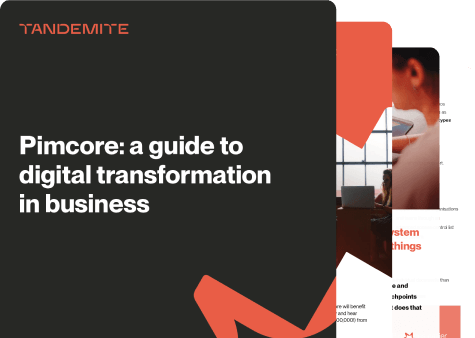Imagine listing a product online when all you're given is an SKU, name, and price – nothing more. While SKUs serve as internal identifiers and help your internal team track inventory, they offer little value to the customer searching for information, inspiration, or assurance.
The average online shopper decides in only a couple of minutes (often under 100 s) whether to click or bounce, based solely on product data. They expect rich, compelling information. That means high-quality images, detailed descriptions, accurate specifications, and persuasive messaging across every channel.
Product content enrichment is the essential process that brings structure and consistency to your catalog. With detailed, complete information, your products are easier to find, cause fewer returns, and help retain customers.
Let’s talk about product data enrichment in PIM systems!
What is product data enrichment?
“Product data enrichment” is a term for a simple concept: making your product information as comprehensive, accurate, and appealing as possible. It’s the process of taking a basic product record (like an SKU with maybe a name and price) and layering on all the additional details that a customer would need.
This includes things like detailed descriptions, technical specifications, dimensions, ingredients or materials, high-quality images, videos, user manuals, and even things like product stories or SEO keywords. Examples:
- Descriptive copy (short & long descriptions, SEO keywords),
- Visuals (images, 360° spins, videos),
- Structured attributes (materials, dimensions, compliance info),
- Localization (translations, region-specific units),
- Channel tweaks (a short spec sheet for B2B, a story-driven blurb for D2C, etc.).
Enriched content includes customer-centric attributes – things that matter to your shoppers – and presents them in a way that enhances the shopping experience. You gather product info from wherever it lives (maybe an ERP system, supplier sheets, your own marketing team’s files), improve and organize that data, and turn it into content that can be published on a website, app, marketplace, print catalog, or any sales channel.
Why call it enrichment? Because you’re literally enriching (adding value to) the product data. Instead of a bland, skeletal record, you end up with a rich, robust product profile. If you’ve ever compared two product pages and picked the one that had more detailed info or better images, you’ve seen the power of product enrichment in action.
Why is it important to enrich product data in your PIM?
✔ Complete, consistent data builds trust. When your product listings have all the info a customer needs (and that info is the same everywhere it appears), customers feel confident. In contrast, if one channel says a shirt is 100% cotton and another lists it as polyester, you’ve got a trust problem. Enrichment via a PIM ensures consistency – the entire enrichment process happens in one place, so when that data is sent out to your website, mobile app, or marketplace listings, it’s all coherent and error-free.
✔ Better enrichment leads to better customer decisions. Detailed size charts, clear usage instructions, rich images from multiple angles – these enriched elements help customers understand the product fully. The result? They’re more likely to hit “Add to cart.” In fact, when product attributes are well-structured and complete, conversions go up because customers find what they need and trust what they see.
✔ Efficiency and scalability for your team. Let’s not forget the internal win. If you’ve been manually updating spreadsheets or coordinating between teams via email, enrichment in a PIM streamlines that. Once data is centralized and processes are in place, your team spends less time fixing errors or hunting down info, and more time improving content.
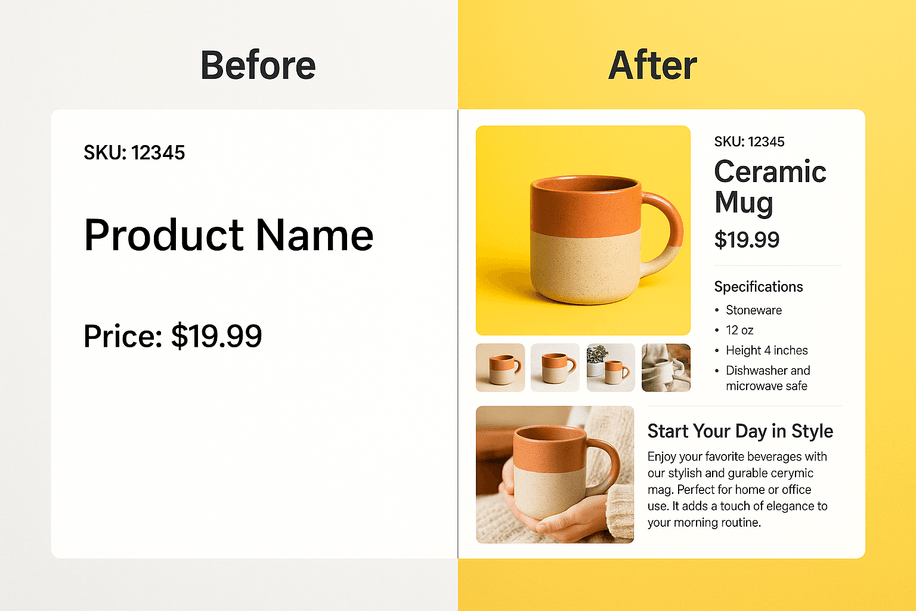
Product enrichment in Akeneo PIM
User-friendly product editing
Akeneo’s interface is built with product teams in mind. When you open a product in Akeneo, you see all its attributes organized into groups (like images, descriptions, technical details, SEO, etc.). You can quickly fill in or update each field. There’s no hunting around in a database or dealing with cryptic menus – it’s all laid out logically. For instance, you might have a “Marketing” attribute group with fields for product name, tagline, and description, and another group for “Specifications” with weight, dimensions, materials, etc.
Families and attributes
Before you enrich, you define your product schema in Akeneo by using Families. A family is a template for products of a certain type – it determines which attributes a product should have. Once that’s set up, every new product in that family will prompt you for those attributes. You won’t forget to add the “Battery life” spec to a phone product because the phone family requires it. When you create a product and assign it a family, Akeneo immediately knows which fields it needs, and you can start filling them in. This guides users through enrichment, ensuring nothing important is left out.
Completeness indicator
One of Akeneo’s killer features is the completeness score. As you enrich a product, Akeneo PIM shows a progress bar or percentage that indicates how much of the required information is filled in. A green 100% means the product is fully enriched (all mandatory fields are filled), while an orange or red percentage means you’ve got work to do. This visual cue is incredibly helpful for prioritizing work – you can filter your product list to see which items are, say, below 80% complete and focus on those. It’s a quick answer to “Are we content-ready to publish this product?”
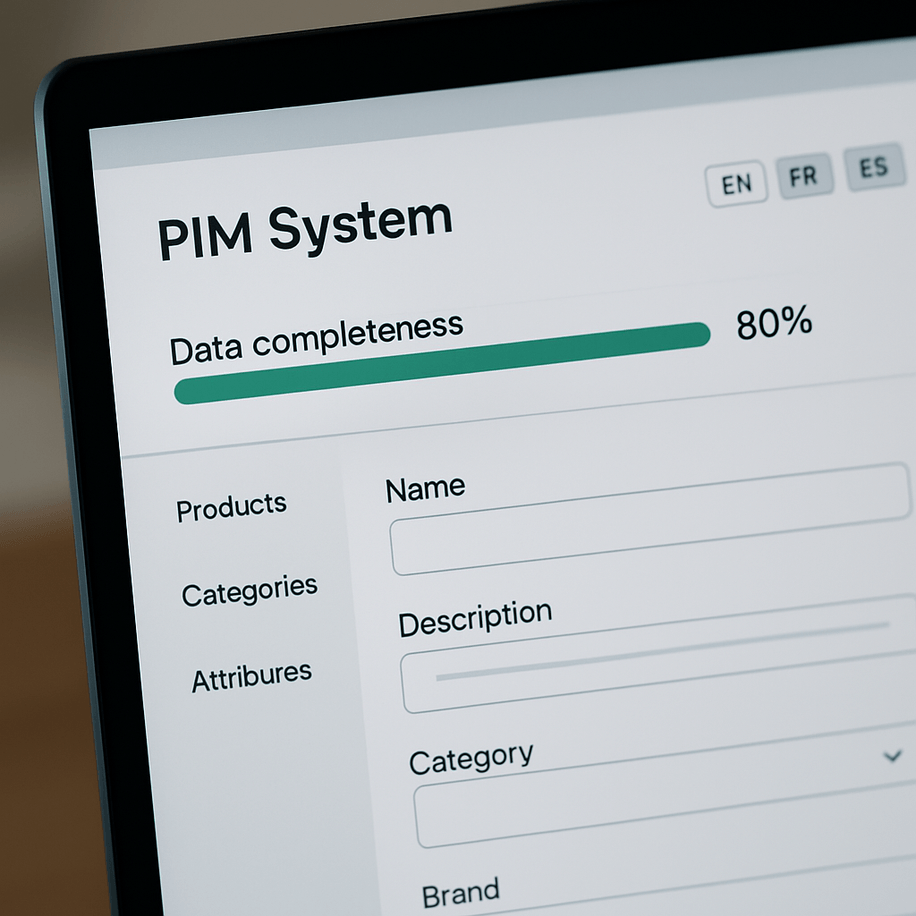
Multi-channel, multi-locale editing
Need to provide different descriptions for different storefronts or translate content for various regions? In PIM Akeneo, you can switch between channels (e.g., retail website vs. wholesale catalog) and locales (e.g., English, French, Italian) in the product form to enter channel-specific or language-specific data. For example, maybe your e-commerce site needs a shorter title while your print catalog allows a longer one; Akeneo lets you manage that in one place. Likewise, you can input a product description in English, then flip to French and input the translation, all within the same product record. This context switching is smooth, ensuring enrichment covers every channel and market you sell in.
Quality and validation
Akeneo also helps maintain data quality as you enrich. You can set up validation rules (for instance, a weight must be a positive number, or the description can’t exceed 500 characters, etc.). If a required field is missing or an entry is invalid, Akeneo will alert you.
Collaboration and workflows (Enterprise Edition)
Akeneo understands that product enrichment is a shared responsibility, not a one-person job. In teams, you might have a copywriter, a data specialist, and a manager all involved in getting a product’s details right. Akeneo’s Enterprise Edition includes workflow features where you can have products go through a review/approval process. For example, a product’s status might start as “Draft” while it’s being enriched, then move to “Ready for review” so a manager can approve it, and finally to “Approved” or “Published”. Akeneo also introduced review steps to its enrichment workflows, allowing content creators and approvers to leave feedback for each other right in the PIM. This kind of built-in collaboration makes the enrichment process more transparent and efficient – no more side emails are needed to get product data finalized!
Bulk actions and automation
Akeneo allows bulk enrichment actions. Let’s say you need to set the “Material” attribute to “100% Cotton” for 50 new t-shirts – you can edit those in one go. Or if a regulation changes and you need to update a safety warning across many products, bulk editing can handle that. Moreover, Akeneo supports rules and automation (in more advanced editions or via extensions) where certain fields can auto-calculate or default based on conditions. All of this reduces the manual labor of enrichment and helps keep data consistent.
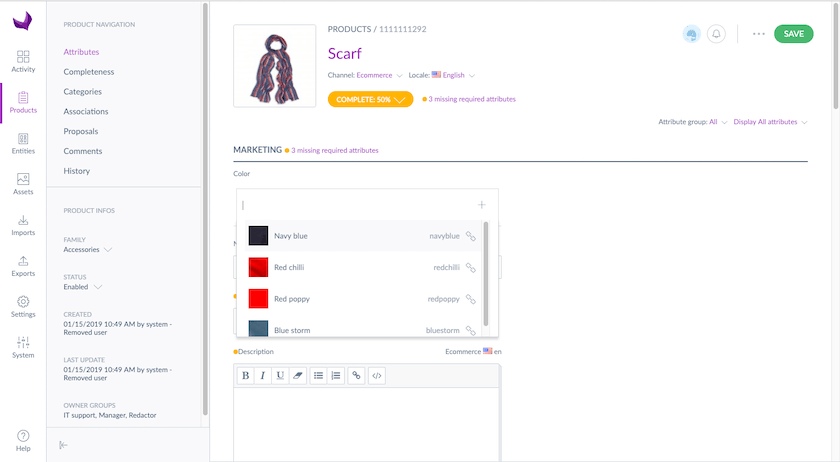
(Source: Akeneo.com)
Product enrichment in Pimcore PIM
A unified data and asset hub with extensibility
With Pimcore, you’re not only managing product textual information but also the related assets and content in one place. As you enrich a product’s attributes, you can upload or link digital assets like images, PDFs, and videos directly to the product. Since Pimcore includes a full Digital Asset Management (DAM) module, you don’t need a separate tool for images. For example, enriching a sneaker product may involve specifying its sizes, materials, and technical attributes, while simultaneously uploading product images, a 360° video, and a care guide in PDF format. Everything lives in one unified platform.
Additionally, Pimcore’s open architecture supports a wide range of extensions and plugins that further enhance enrichment workflows. Whether it’s advanced translation tools, AI-based image tagging, or integration with external content providers, these add-ons help scale and customize your PIM environment to fit specific business needs.
Flexible data modeling
Before you start enrichment in Pimcore, you (or your implementation partner) will set up a product data model by creating a Product class with all the needed attributes. The beauty of Pimcore is that it doesn’t impose a fixed structure – you define exactly what fields and data types your products have. Need a complex structure of related data (like a product composed of multiple sub-components, each with their own attributes)? Pimcore can model that.
This flexibility is a double-edged sword: it’s powerful, but it requires careful planning. Once your classes are defined, though, enriching data is straightforward – Pimcore’s back-end UI will present users with a form for each product object, with all the custom fields ready to fill in.
Enrich via a graphical user interface or imports
Pimcore allows you to enrich product data directly through its graphical user interface, just like Akeneo, but it also has strong integration capabilities. You can import data from other systems or spreadsheets to jump-start enrichment, and then refine it in the GUI.
The Pimcore documentation notes that products can be created and enriched directly in the PIM environment through the GUI, and of course, you can also bring data in via files or integrations. So if you’re transitioning to Pimcore, you might do an initial bulk import of basic data, then use the GUI to enrich and polish the details.
Custom attributes and relationships
Enrichment in Pimcore PIM often involves linking products to other data objects, thanks to its Master Data Management (MDM) capabilities. For instance, you might have separate data objects for “Brand”, “Supplier”, or “Material”. While enriching a product, instead of typing a brand name every time (and risking typos), you link the product to a Brand object. This ensures consistency and saves time.
Pimcore supports one-to-many, many-to-many, and hierarchy relationships as part of enrichment. Enriching a product might involve selecting a category from a tree, relating the product to its materials, and so on. These relationships enrich the product data model beyond flat fields – you’re creating a web of connected information. It’s very powerful for companies with complex product data (think of a product that has spare parts, accessories, or is part of a bundle – PIM Pimcore can represent those links).
Versioning and workflows
Pimcore also supports versioning of data and can be configured for workflows. You can keep track of changes to product data and even roll back if needed. You can configure custom workflows for approval processes, or use Pimcore’s built-in user roles/permissions to manage who can edit vs. publish data. In essence, you have the tools to create an editorial process for enrichment if your organization needs one.
Handling scale and performance
One thing to appreciate – Pimcore is built to handle a lot of data. If you have millions of SKUs, Pimcore’s architecture can manage it. For enrichment, this means even if your catalog is huge, the system can support it, and you can optimize how data is entered. Akeneo can also handle very large catalogs, but Pimcore’s enterprise-grade flexibility is a big plus if you expect massive scale or highly varied product types.
Technical flexibility (and complexity)
With Pimcore, if there’s something you wish the enrichment UI could do, you can often customize it. Because it’s open-source and developer-friendly, companies extend Pimcore to fit their processes. For example, integrating AI to auto-generate descriptions or translations, or creating custom input widgets for certain attributes (like a color picker field for a color attribute).
The trade-off is that this typically requires development effort. Akeneo, by comparison, might offer those features as plug-and-play modules or in premium editions (like Akeneo’s built-in AI suggestions or the Rules Engine), whereas Pimcore lets you craft them if they’re not already in place.
Pimcore’s flexibility comes with complexity: for new users, Pimcore’s interface might seem a bit more overwhelming at first. Implementing it may take more time and technical know-how, but you end up with a tightly tailored solution.
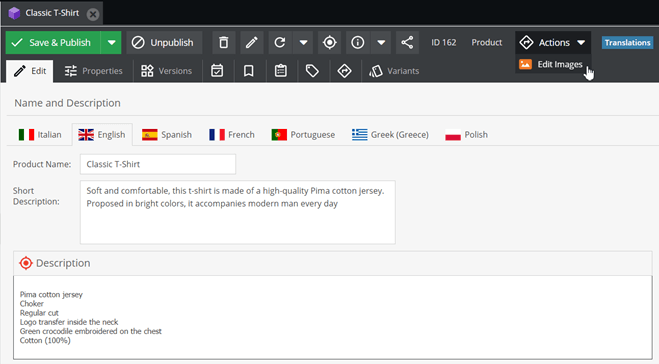
(Source: Pimcore.com)
Tips for adjusting to a new PIM (data enrichment for beginners)
Change is a natural part of progress, but adjusting to a new tool can raise questions. Don’t worry – we’ve got some tips to make your transition smoother:
1️⃣ Get everyone on the same page. Before, different departments might have managed product info in their own files. Step one of adopting a PIM is to centralize that knowledge. Gather representatives from marketing, sales, e-commerce, supply chain – whoever touches product data – and map out what info they have and need. By involving all stakeholders early, you ensure the PIM will serve everyone’s needs, and you’ll get buy-in because people see their input reflected.
2️⃣ Define your enrichment process. Take a moment to sketch how product enrichment will flow in the new system. Who creates a new product in the PIM? Who fills in the initial details? Does someone review it before it’s considered “done”? Maybe your process is: Item created from ERP import → data team enriches technical specs → marketing team adds descriptions and images → e-commerce manager approves for publication. Write that down, configure it in the tool if possible, and let everyone know the game plan. This might feel formal if you’re a small team, but even a simple checklist helps.
Remember, the entire product enrichment process should occur in the PIM (not in scattered spreadsheets) to keep data consistent, so you want a clear process inside the PIM.
3️⃣ Clean up your data. When moving to a PIM, you have a golden opportunity to improve data quality. Those weird characters, outdated descriptions, and missing photos – now’s the time to fix them. Consider running a data audit or using PIM features to highlight issues. Clean data not only makes the initial enrichment easier, but it sets a quality baseline. PIMs often let you enforce rules so that, for example, you can’t save a product if certain key fields are empty. Is it okay to publish without an image? Without a description? Probably not. Decide on those rules based on what will truly break a product page or confuse a customer if absent.
4️⃣ Leverage training and documentation. Even though Akeneo and Pimcore are user-friendly, they’re new to your team. Host a training session (or several). Many PIM partners offer training materials. Create a simple internal guide for your specific setup: e.g., “How to add a new product in our PIM – 10 steps” or “Before marking a product as complete, check these things.” The more comfortable they are navigating the PIM, the faster your enrichment process will go.
5️⃣ Use the PIM’s strengths – automation and bulk actions. As you get comfortable, explore things like bulk edit, imports, or scripts to handle repetitive tasks.
Old way: updating 50 products = 50 manual edits. New way: update one, apply to 49 others with a few clicks (or even set a rule to do it automatically).
6️⃣ Monitor and iterate. After you’ve enriched products and pushed them to your channels, keep an eye on how that content is performing. Are customers still asking questions that your descriptions should answer? Perhaps you need to enrich with an FAQ or more details. Are returns happening because specs were misunderstood? Maybe make them clearer in the data.
Summary
Moving to a proper PIM system for enrichment can be a game-changer. Instead of juggling multiple files and formats, you’ll centralize everything.
Product enrichment in Akeneo and Pimcore ultimately serves the same purpose: to help you deliver better product experiences by ensuring your product data is complete, accurate, and compelling.
For end-users new to PIM, it might require adjusting to a structured process. Yes, you’ll have a learning curve. Yes, you’ll need to adjust some habits. But the payoff is huge in efficiency and data quality.
At Tandemite, we help businesses navigate the twists and turns of product information management so you can launch new products faster and free your teams from spreadsheet chaos.
Akeneo or Pimcore – whichever direction you take, a skilled implementation partner can help you avoid pitfalls and accelerate your results. Contact us and let’s talk about your challenges.





